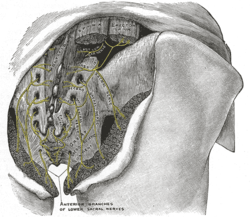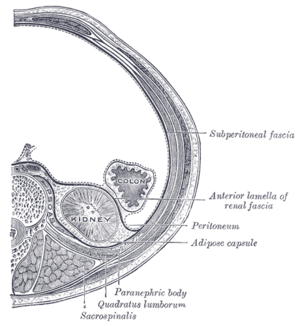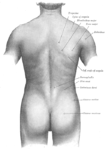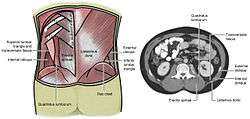Erector spinae muscles
| Erector spinae | |
|---|---|
 The erector spinae muscle group | |
| Details | |
| Origin | Spinous processes of T9-T12 thoracic vertebrae, medial slope of the dorsal segment of illiac crest |
| Insertion | spinous processes of T1 and T2 thoracic vertebrae and the cervical vertebrae |
| Artery | lateral sacral artery |
| Nerve | posterior branch of spinal nerve |
| Actions | extends the vertebral column |
| Antagonist | rectus abdominis muscle |
| Identifiers | |
| Latin | Musculus erector spinae |
| TA | A04.3.02.002 |
| FMA | 71302 |
The erector spinae (/ˌᵻˈrɛktər ˈspaɪniː/ ə-REK-tər SPEYE-nee)[1] or spinal erectors is a set of muscles that straighten and rotate the back.
Structure
The erector spinae is not just one muscle, but a bundle of muscles and tendons. It is paired and runs more or less vertically. It extends throughout the lumbar, thoracic and cervical regions, and lies in the groove to the side of the vertebral column. Erector spinae is covered in the lumbar and thoracic regions by the thoracolumbar fascia, and in the cervical region by the nuchal ligament.
This large muscular and tendinous mass varies in size and structure at different parts of the vertebral column. In the sacral region, it is narrow and pointed, and at its origin chiefly tendinous in structure. In the lumbar region, it is larger, and forms a thick fleshy mass. Further up, it is subdivided into three columns. These gradually diminish in size as they ascend to be inserted into the vertebrae and ribs.
The erector spinae arises from the anterior surface of a broad and thick tendon. It is attached to the medial crest of the sacrum, to the spinous processes of the lumbar and the eleventh and twelfth thoracic vertebrae and the supraspinous ligament, to the back part of the inner lip of the iliac crests, and to the lateral crests of the sacrum, where it blends with the sacrotuberous and posterior sacroiliac ligaments.
Some of its fibers are continuous with the fibers of origin of the gluteus maximus.
The muscular fibers form a large fleshy mass that splits, in the upper lumbar region, into three columns, viz., a lateral (Iliocostalis), an intermediate (Longissimus), and a medial (Spinalis). Each of these consists of three parts, inferior to superior, as follows:
Iliocostalis
The iliocostalis originates from the sacrum, erector spinae aponeurosis and iliac crest. The iliocostalis has three different insertions according to the parts:
- iliocostalis lumborum has the lumbar part(where its insertion is in the 12th to 7th ribs)
- iliocostalis thoracis where its insertion runs from the last 6 ribs to the first 6 ribs.
- iliocostalis cervicis which runs from the first 6 ribs to the posterior tubercle of the transverse process of C6-C4.
Longissimus
The longissimus muscle is the intermediate and the largest of the three columns, it has three parts with different origin and insertion:
- longissimus thoracis originates from the sacrum, spinous processes of the lumbar vertebrae and transverse process of the last thoracic vertebra and inserts in the transverse processes of the lumbar vertebrae, erector spinae aponeurosis, ribs and costal processes of the thoracic vertebrae.
- longissimus cervicis originates from the transverse processes of T6-T1 and inserts in the transverse processes of C7-C2.
- longissimus capitis originates from the transverse processes of T3-T1 runs through C7-C3 and inserts in the mastoid process of the temporal bone.
Spinalis
The spinalis muscle is the most medial and the smallest column. It has three parts:
- spinalis thoracis which originates from the spinous process of L3-T10 and inserts in the spinous process of T8-T2.
- spinalis cervicis originates from the spinous process of T2-C6 and inserts in the spinous process of C4-C2.
- spinalis capitis is an inconstant muscles fibres that runs from the cervical and upper thoracic that then inserts in the external occipital protuberance.
| Insertion | Lateral Column Iliocostalis | Intermediate Column Longissimus | Medial Column Spinalis |
| Lower thoracic vertebrae and ribs | I. lumborum | ||
| Upper thoracic vertebrae and ribs | I. thoracis | L. thoracis | S. thoracis |
| Cervical vertebrae | I. cervicis | L. cervicis | S. cervicis |
| Skull | L. capitis | S. capitis |
From lateral to medial, the erector spinae muscles can be remembered using the mnemonic, I Love Spine. I lliocostalis, Love Longissimus and Spine Spinalis.[2]
Training
Examples of exercises by which the erector spinae can be strengthened for therapeutic or athletic purposes include, but are not limited to:
- Bent-over row
- Deadlift
- Hyperextension
- Good-morning
- Pull-up (exercise)
- Rowing
- Squat
- Utkatasana
- Bridge (exercise)
Additional images
-

Right hip bone. Internal surface.
-

Diagram of a transverse section of the posterior abdominal wall, to show the disposition of the lumbodorsal fascia.
-

The posterior divisions of the sacral nerves.
-

Transverse section, showing the relations of the capsule of the kidney.
-

Surface anatomy of the back.
-

Lumbar triangle
References
This article incorporates text in the public domain from the 20th edition of Gray's Anatomy (1918)
- ↑ "How to pronounce spinae in English". Cambridge University Press 2015. Retrieved 10 December 2015.
- ↑ "Medical mnemonic". LifeHugger. Retrieved 2009-12-15.
External links
- -596967347 at GPnotebook
- Anatomy figure: 01:05-03 at Human Anatomy Online, SUNY Downstate Medical Center - "Intermediate layer of the extrinsic muscles of the back, deep muscles."
- ithaca.edu